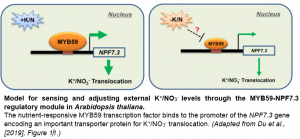It’s an Uphill Battle: The MYB59-NPF7.3 Regulatory Module and its Role in Nutrient Transport
Fertilizer use in agriculture is one of the essential strategies in improving crop productivity and ensuring global food security. Two primary nutrients in fertilizers are potassium (K+) and nitrate (NO3–), which are vital for proper plant function. In order to formulate better approaches in optimizing fertilizer use, it is crucial that we have a thorough understanding of how plants effectively respond to and transport these nutrients. Achieving this could result in higher agricultural yields with lower environmental impacts (Zhang, 2017).
Plants accurately detect K+ and NO3–, and adjust uptake and transport of these ions according to their availability and the needs of the plant. Interestingly, a single transporter protein, NRT1.5/NPF7.3, can transport both K+ and NO3– from the root to the shoot (Lin et al., 2008; Li et al., 2017). Although previous studies have shown that NRT1.5/NPF7.3 gene expression is influenced by changes in K+/NO3– levels (Wang et al., 2004; Li et al., 2017), the mechanistic basis of this gene expression regulation has remained elusive. New work by Du et al. (2019) shows that MYB59 regulates K+ and NO3– transport in response to low K+ or NO3– conditions by activating NPF7.3 transcription.
Using a genetic screen of 400 Arabidopsis T-DNA insertion lines and ensuing validation, the authors showed that the MYB59 transcription factor controls response to K+ deficiency. Detailed physiological analyses of the myb59 mutants revealed that, under low external K+ conditions, both K+ and NO3– ions accumulated more in their roots but less in their shoots, when compared to the wild-type plants. This suggested a functional role of MYB59 in K+ and NO3– translocation.
 Consistent with the similar phenotypes of myb59 and npf7.3 mutants, global transcriptome analyses showed that the transporter gene NPF7.3 is downregulated in the myb59 mutant. Expression of NPF7.3 rescued the low K+ phenotype of the myb59 mutant, indicating that NPF7.3 lies downstream of MYB59, and that the myb59 mutant phenotypes are largely explained by the deficiency of NPF7.3.
Consistent with the similar phenotypes of myb59 and npf7.3 mutants, global transcriptome analyses showed that the transporter gene NPF7.3 is downregulated in the myb59 mutant. Expression of NPF7.3 rescued the low K+ phenotype of the myb59 mutant, indicating that NPF7.3 lies downstream of MYB59, and that the myb59 mutant phenotypes are largely explained by the deficiency of NPF7.3.
But does MYB59 directly or indirectly regulate NPF7.3 gene expression (see Figure)? Du et al. (2019) answered this fundamental question by testing whether MYB59 directly binds the promoter of the NPF7.3 gene. Chromatin immunoprecipitation experiments, coupled with mobility shift assays, provided evidence for the direct transcriptional regulation of NPF7.3 by MYB59. This transcriptional cascade seemed to be directed by external nutrient levels, as MYB59 and NPF7.3 gene expression levels were reduced under either low K+ or low NO3– stress conditions. Interestingly, low K+ levels also regulated the MYB59 transcription factor at the protein level in a proteasome-dependent manner.
It would be exciting for future studies to investigate the upstream regulators linking nutrient perception and MYB59 gene transcription. How does MYB59 fit into the broader network that coordinates K+ and NO3– nutrition? How is it linked to other nutrient transport streams? Additionally, if (and how) post-translational modifications of MYB59 and its binding to target promoters are perturbed by external stimuli would be great research directions to pursue. Sorting out the mechanism of how MYB59 protein stability is regulated by K+ levels may also reveal how plants sense low K+. Overall, the results presented by Du et al. (2019) shed more light on the molecular players and pathways that are important for root-to-shoot K+/NO3– translocation. From broad genetic and genomic approaches to more detailed biochemical and physiological analyses, the authors demonstrated that MYB59-NPF7.3 represents a central regulatory hub for plants to adapt to rapidly changing nutrient conditions.
REFERENCES
Du XQ, Wang FL, Li H, Jing S, Yu M, Li J, Wu WH, Kudla J, Wang Y (2019). Transcription factor MYB59 regulates K+/NO3– translocation in Arabidopsis response to low K+ stress. Plant Cell. https://doi.org/10.1105/tpc.18.00674
Li H, Yu M, Du XQ, Wang ZF, Wu WH, Quintero FJ, Jin XH, Li HD, Wang Y (2017). NRT1.5/NPF7.3 functions as a proton-coupled H+/K+ antiporter for K+ loading into the xylem in Arabidopsis. Plant Cell 29: 2016-2026. doi: https://doi.org/10.1105/tpc.18.00972.
Lin SH, Kuo HF, Canivenc G, Lin CS, Lepetit M, Hsu PK, Tillard P, Lin HL, Wang YY, Tsai CB, Gojon A, Tsay YF (2008). Mutation of the Arabidopsis NRT1.5 nitrate transporter causes defective root-to-shoot nitrate transport. Plant Cell 20: 2514-2528. doi: https://doi.org/10.1105/tpc.108.060244 .
Wang R, Tischner R, Gutiérrez RA, Hoffman M, Xing X, Chen M, Coruzzi G, Crawford NM (2004). Genomic analysis of the nitrate response using a nitrate reductase-null mutant of Arabidopsis. Plant Physiol. 136: 2512-2522.
Zhang X (2017). A plan for efficient use of nitrogen fertilizers. Nature 543: 322-323. doi: 10.1038/543322a



